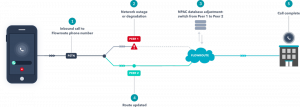Reliability in communication networks in the best of situations means that calls and messages are guaranteed to reach their destination complete, secure, and in the order they were sent. Balancing constraints like cost and performance are also part of the mix.
Reliability also encompasses the ability to recover from infrastructure or service disruptions, dynamically acquire alternative paths, and mitigate disruptions quickly.
Network reliability can be measured by the frequency of failure, the time it takes to recover from a failure, and the robustness of the network. When a network isn’t reliable it can make delays longer than expected. Continuous improvement in the reliability of communication networks is an ongoing challenge.
Here are a few important ways to help improve reliability:
- Improve the reliability of individual components of the network
- Increase the number of alternative paths available
- Improve the experience of disruption mitigation
Make sure you have a reliable network structure
Your network structure is the backbone of your daily operations. It’s how you most often communicate with your customers and it largely depends on the reliability of your network structure.
Business operations such as client acquisition and retention, maintaining critical records, and tracking revenue depend on reliable and secure connections. An unstable network structure can immediately impact your operations, including customer service and support. If clients can’t reach your company for support whenever they need it may lead to negative feedback about your products and services.
Additionally, an unreliable network opens your business up to data breaches and attacks. As cyber criminals think of more complex scams, the chances that critical company data can be hacked and stolen are very high.
Cloud-centric networking models are often faster and more flexible than purely legacy infrastructure models. Modern communication networks are designed to deliver an entire end-to-end experience that matches short and long-term customer needs and expectations. Using more intelligent network services to orchestrate and quickly deliver connectivity to telco infrastructure enables customers to turn up secure services in minutes instead of weeks and serve demand immediately.
Customers now can use click-to-connect provisioning to meet their dynamic needs. Unlocking cloud agility with a network that is ready to deploy services on demand is a huge competitive advantage in today’s fast-paced business environment.
The Flowroute HyperNetwork Difference
At Flowroute, now part of Intrado, we utilize our patented HyperNetwork and our carrier status to determine if there is a network outage. When there is an outage, the Hypernetwork automatically reroutes the physical and logical paths of inbound calls to bypass the outage and enable our customers to resume normal operations with limited interruption.
The exclusive Flowroute HyperNetwork helps businesses replace multiple vendors and interfaces with a single telecom network, managed through our intuitive portal. Our communication platform enables independent software vendors, communication service providers (CSPs), value-added resellers (VARs) and managed service providers (MSPs) and enterprises of all sizes to quickly and easily migrate premise-based communication systems to voice over internet protocol (“VoIP”) and customize and automate services with application programming interfaces (“APIs”).
Flowroute removes the complexity of bringing new communications solutions to market by providing businesses with innovative programmatic access to communications infrastructure services. We deliver adaptive call routing to provide inbound and outbound redundancy by rerouting the physical and logical path of calls in the event of a catastrophic event. We use our HyperNetwork to intelligently bypass the outage so our customers can resume their normal operations more quickly versus waiting for an outage resolution by a third party/local carrier.
Owning the network allows us to have more granular controls to influence network availability. And, our world-class support team’s response time is, on average, less than 15 minutes. Network intelligence that includes continuous troubleshooting and optimization will help deliver the performance that cloud and on-demand services need. Observing network behavior in real-time and instantly comparing it to historical network data vastly improves performance, consistency, and reliability.
Companies are also integrating networks through our APIs that enable a global marketplace where a multitude of infrastructure and application services can be activated to create tailored offerings.







